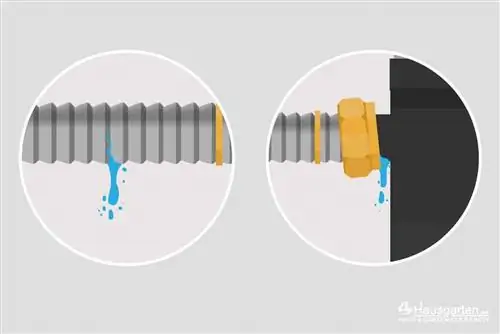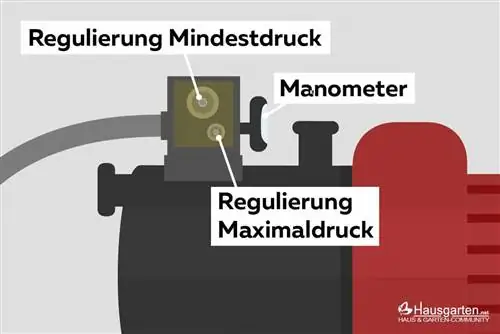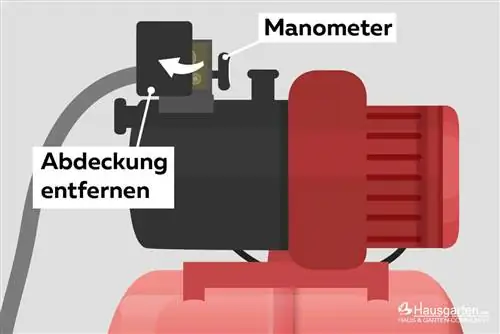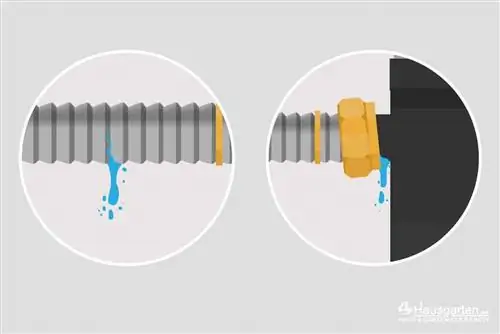- Author admin [email protected].
- Public 2023-12-17 03:39.
- Last modified 2025-01-24 12:45.
The domestic waterworks can be an alternative or an addition to the regular water supply. If it doesn't draw water, energy is consumed but the function is no longer fulfilled.
Possible causes
The potential reasons why the domestic waterworks no longer draws water are varied. They also depend on the type of domestic waterworks. These are differentiated into:
- self-priming pumps
- non-self-priming domestic waterworks
- self-ventilating devices
- non-self-bleeding pumps
Knowing the type of model in question helps to find the cause more quickly and to discover which problems are responsible.
Insufficient depth
Especially with self-priming domestic water systems or pumps, an insufficient depth can quickly mean that the appropriate amount of water can no longer be sucked in. With non-self-priming domestic water systems, just a few air bubbles are enough to negatively affect the function or even lead to a complete shutdown. Therefore, attention should always be paid to the required depth, because the delivery line must extend far enough into the water.
This can be easily ensured when reinstalling. Please note that the pump performance is designed for the depth.
Leaky pipes
A leaky line or leaky valves can mean that sufficient pressure can no longer be built up. Air can also be sucked in. The delivery lines as well as valves and seals must therefore be checked at every domestic waterworks if it no longer draws water.
In some cases it is enough to reinsert seals correctly, seal a leak or screw a connection tight again. In other cases, the relevant components must be replaced. This can apply, for example, if the material has become porous or even has cracks.

Tip:
Regular inspections of the system help to detect such damage at an early stage. This keeps the extent of the problem small and is often easier to fix. This means that effort and costs can be saved or kept low.
Missing ventilation
If it is a model without a self-venting function, the air must be removed manually. This action should be done manually. It is important that ventilation takes place regularly. It is ideal to do it before each new start-up if it is a pump in the garden.
In addition, the manufacturer's instructions must be followed in order to operate the venting screw and, if necessary, the lines must also be vented. However, even with domestic water systems with automatic ventilation, the problem can arise if there is a fault or damage.
Incorrect settings
If the pressure valve and pressure switch are not set appropriately to the delivery depth, the domestic waterworks can run continuously and deliver too little water. It is also possible that water is no longer attracted.
This problem can occur with any type of domestic water system. It is therefore important, on the one hand, to select a model with the appropriate delivery capacity. On the other hand, the setting must be made correctly. The manufacturer's instructions must be observed.
Problems with the filter
Various problems can occur in the area of the filter which ensure that the domestic waterworks no longer draws water. These are:
- Contamination up to clogging
- Holes or leaks
- loose connections
If the water contains foreign substances and coarse dirt, these can clog and clog the filter. When maintaining the pump or if the domestic waterworks draws less or no water at all, the filter should also be checked.
Tip:
If it needs to be cleaned or if there are other problems and if these are discovered early, they can usually be solved quickly and easily.
Defective valves
In non-self-priming domestic water systems there are one or more so-called check valves. These prevent the water from flowing back and out of the pipe. Possible reasons for the lack of drawing water can therefore also be found in the area of the valves.
- Pollution
- Rust or defective
- lack of closure, for example through porous seals
If the filter is leaking, dirt can enter the line and cause blockages or prevent the valves from closing properly. In both cases no more water can be attracted. The same applies if the valves are defective.
To avoid this or if no errors can be found elsewhere, the valves should also be checked. Flushing the line can help eliminate the cause of the lack of tightening. A replacement is necessary if there are defects.
IMPORTANT:
However, this is not always easy for laypeople to do. If necessary, the domestic waterworks must be repaired by specialists in order to replace defective valves.






